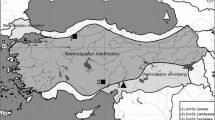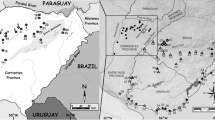Abstract
Ten individuals of Uromys caudimaculatus sampled from Queensland gave evidence for the occurrence of two distinct chromosome races characterised by marked differences in their pattern of C-banding. In all four individuals from the north, thirteen of the twenty three chromosome which make up the standard haploid set had substantial distal C-blocks in addition to the smaller centric blocks which characterise all chromosomes other than the Y. Additionally two pairs had an interstitial block. By contrast none of the six southern individuals had fixed distal blocks though all of them except the Y carry pro-centric C-blocks and again one pair showed an interstitial block. The southern karyotype was, however, characterised by the presence of from six to nine mitotically stable supernumerary chromosomes all of which were totally C-positive despite the fact that at least five morphologically distinguishable types have been defined. While the relationship of these two types of constitutive heterochromatin remains to be clarified the large amount present in both northern and southern animals suggests that heterochromatin plays an important role in the basic biology of this species.
Similar content being viewed by others
References
Arrighi, F.E., Hsu, T.C.: Localization of heterochromatin in human chromosomes. Cytogenetics 10, 81–86 (1971)
Buckton, K.E., Cunningham, C.: Variations in the chromosome number in the red fox (Vulpes vulpes). Chromosoma (Berl.) 33, 268–272 (1971)
Dartnall, J.A.: The chromosomes of some Tasmanian rodents. Papers Proc. roy. Soc. Tas. 104, 79–80 (1970)
Gilera, E.A.: B-chromosomes, unusual inheritance of sex chromosomes, and sex ratio in the Arctic lemming [Dicrostonyx torquatus torquatus Pall. (1779)]. Dokl. Akad. Nauk SSSR 213, 952–955 (1973)
Hayata, I.: Chromosomal polymorphism caused by supernumerary chromosomes in the field mouse, Apodemus giliacus. Chromosoma (Berl.) 42, 403–414 (1973)
Hsu, T.C., Arrighi, F.E.: Distribution of constitutive heterochromatin in mammalian chromosomes. Chromosoma (Berl.) 34, 343–353 (1971)
Kennedy, J.A.: The karyotypes of some Australian rodents (Rodentia: Muridae). Aust. J. Zool. 17, 465–471 (1969)
Pathak, S., Hsu, T.C., Arrighi, F.E.: Chromosomes of Peromyscus (Rodentia, Cricetidae). IV. The role of heterochromatin in karyotype evolution. Cytogenet. Cell Genet. 12, 315–326 (1973)
Patton, J.L.: A complex system of chromosomal variation in the pocket mouse, Perognathus baileyi Merriam. Chromosoma (Berl.) 36, 241–255 (1972)
Raman, R., Sharman, T.: DNA replication, G- and C-bands and meiotic behaviour of supernumerary chromosomes of Rattus rattus (Linn.). Chromosoma (Berl.) 45, 111–119 (1974)
Shellhammer, H.S.: Supernumerary chromosomes of the harvest mouse, Reithrodontomys megalotis. Chromosoma (Berl.) 27, 102–108 (1969)
Yosida, T.H., Sagai, T.: Variation of C-bands in the chromosomes of several subspecies of Rattus rattus. Chromosoma (Berl.) 50, 283–300 (1975)
Author information
Authors and Affiliations
Rights and permissions
About this article
Cite this article
Baverstock, P.R., Watts, C.H.S. & Hogarth, J.T. Heterochromatin variation in the Australian rodent Uromys caudimaculatus . Chromosoma 57, 397–403 (1976). https://doi.org/10.1007/BF00332163
Received:
Accepted:
Issue Date:
DOI: https://doi.org/10.1007/BF00332163




